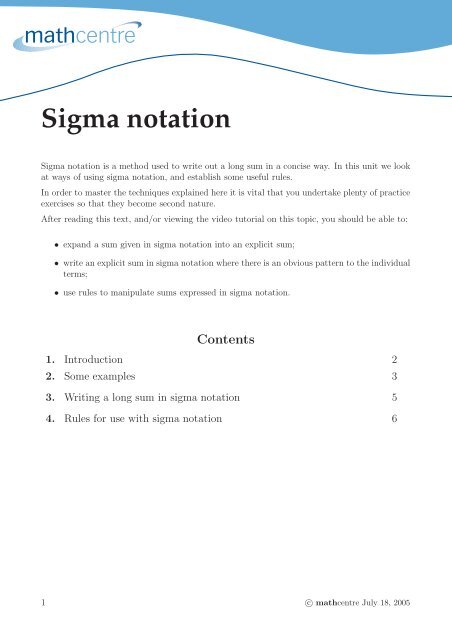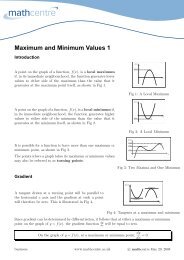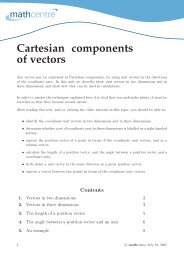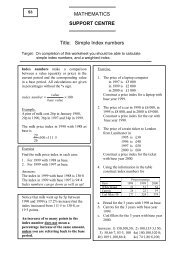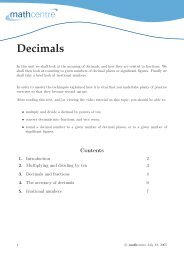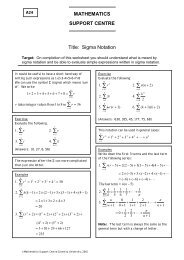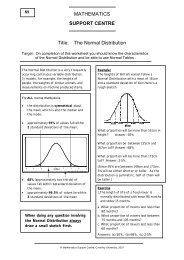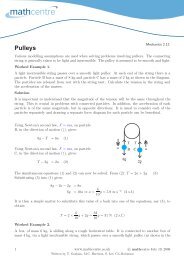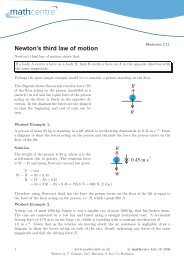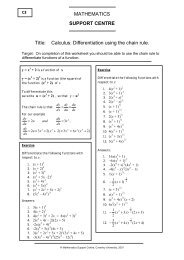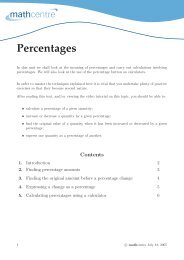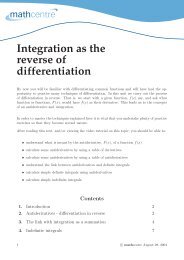Sigma notation - Mathcentre
Sigma notation - Mathcentre
Sigma notation - Mathcentre
You also want an ePaper? Increase the reach of your titles
YUMPU automatically turns print PDFs into web optimized ePapers that Google loves.
<strong>Sigma</strong> <strong>notation</strong><br />
<strong>Sigma</strong> <strong>notation</strong> is a method used to write out a long sum in a concise way. In this unit we look<br />
at ways of using sigma <strong>notation</strong>, and establish some useful rules.<br />
In order to master the techniques explained here it is vital that you undertake plenty of practice<br />
exercises so that they become second nature.<br />
After reading this text, and/or viewing the video tutorial on this topic, you should be able to:<br />
• expand a sum given in sigma <strong>notation</strong> into an explicit sum;<br />
• write an explicit sum in sigma <strong>notation</strong> where there is an obvious pattern to the individual<br />
terms;<br />
• use rules to manipulate sums expressed in sigma <strong>notation</strong>.<br />
Contents<br />
1. Introduction 2<br />
2. Some examples 3<br />
3. Writing a long sum in sigma <strong>notation</strong> 5<br />
4. Rules for use with sigma <strong>notation</strong> 6<br />
1 c○ mathcentre July 18, 2005
1. Introduction<br />
<strong>Sigma</strong> <strong>notation</strong> is a concise and convenient way to represent long sums. For example, we often<br />
wish to sum a number of terms such as<br />
or<br />
1 + 2 + 3 + 4 + 5<br />
1 + 4 + 9 + 16 + 25 + 36<br />
where there is an obvious pattern to the numbers involved. The first of these is the sum of<br />
the first five whole numbers, and the second is the sum of the first six square numbers. More<br />
generally, if we take a sequence of numbers u 1 , u 2 , u 3 , . . .,u n then we can write the sum of these<br />
numbers as<br />
u 1 + u 2 + u 3 + . . . + u n .<br />
A shorter way of writing this is to let u r represent the general term of the sequence and put<br />
n∑<br />
u r .<br />
r=1<br />
Here, the symbol Σ is the Greek capital letter <strong>Sigma</strong> corresponding to our letter ‘S’, and refers<br />
to the initial letter of the word ‘Sum’. So this expression means the sum of all the terms u r<br />
where r takes the values from 1 to n. We can also write<br />
b∑<br />
r=a<br />
to mean the sum of all the terms u r where r takes the values from a to b. In such a sum, a is<br />
called the lower limit and b the upper limit.<br />
u r<br />
Key Point<br />
The sum u 1 + u 2 + u 3 + . . . + u n is written in sigma <strong>notation</strong> as<br />
n∑<br />
u r .<br />
r=1<br />
c○ mathcentre July 18, 2005 2
Exercises<br />
1. Write out what is meant by<br />
(a)<br />
(e)<br />
5∑<br />
n=1<br />
N∑<br />
n 3<br />
x 2 i<br />
i=1<br />
(b)<br />
(f)<br />
5∑<br />
3 n (c)<br />
n=1<br />
N∑<br />
f i x i<br />
i=1<br />
4∑<br />
(−1) r r 2<br />
r=1<br />
(d)<br />
4∑<br />
k=1<br />
(−1) k+1<br />
2k + 1<br />
2. Evaluate<br />
4∑<br />
k 2 .<br />
k=1<br />
2. Some examples<br />
Example<br />
4∑<br />
Evaluate r 3 .<br />
Solution<br />
r=1<br />
This is the sum of all the r 3 terms from r = 1 to r = 4. So we take each value of r, work out r 3<br />
in each case, and add the results. Therefore<br />
Example<br />
5∑<br />
Evaluate n 2 .<br />
Solution<br />
n=2<br />
4∑<br />
r 3 = 1 3 + 2 3 + 3 3 + 4 3<br />
r=1<br />
= 1 + 8 + 27 + 64<br />
= 100 .<br />
In this example we have used the letter n to represent the variable in the sum, rather than r.<br />
Any letter can be used, and we find the answer in the same way as before:<br />
Example<br />
5∑<br />
Evaluate 2 k .<br />
k=0<br />
5∑<br />
n 2 = 2 2 + 3 2 + 4 2 + 5 2<br />
n=2<br />
= 4 + 9 + 16 + 25<br />
= 54 .<br />
3 c○ mathcentre July 18, 2005
Solution<br />
Notice that, in this example, there are 6 terms in the sum, because we have k = 0 for the first<br />
term:<br />
5∑<br />
2 k = 2 0 + 2 1 + 2 2 + 2 3 + 2 4 + 2 5<br />
Example<br />
6∑<br />
1<br />
Evaluate r(r + 1).<br />
2<br />
Solution<br />
r=1<br />
k=0<br />
= 1 + 2 + 4 + 8 + 16 + 32<br />
= 63 .<br />
You might recognise that each number 1 r(r + 1) is a triangular number, and so this example<br />
2<br />
asks for the sum of the first six triangular numbers. We get<br />
6∑<br />
r=1<br />
1<br />
2 r(r + 1) = ( 1<br />
2 × 1 × 2) + ( 1<br />
2 × 2 × 3) + ( 1<br />
2 × 3 × 4) + ( 1<br />
2 × 4 × 5)<br />
+ ( 1<br />
2 × 5 × 6) + ( 1<br />
2 × 6 × 7)<br />
= 1 + 3 + 6 + 10 + 15 + 21<br />
= 56 .<br />
What would we do if we were asked to evaluate<br />
n∑<br />
2 k ?<br />
k=1<br />
Now we know what this expression means, because it is the sum of all the terms 2 k where k<br />
takes the values from 1 to n, and so it is<br />
n∑<br />
2 k = 2 1 + 2 2 + 2 3 + 2 4 + . . . + 2 n .<br />
k=1<br />
But we cannot give a numerical answer, as we do not know the value of the upper limit n.<br />
Example<br />
4∑<br />
Evaluate (−1) r .<br />
Solution<br />
r=1<br />
Here, we need to remember that (−1) 2 = +1, (−1) 3 = −1, and so on. So<br />
4∑<br />
(−1) r = (−1) 1 + (−1) 2 + (−1) 3 + (−1) 4<br />
r=1<br />
= (−1) + 1 + (−1) + 1<br />
= 0 .<br />
c○ mathcentre July 18, 2005 4
Example<br />
3∑<br />
Evaluate<br />
Solution<br />
k=1<br />
(<br />
− 1 k) 2<br />
.<br />
Once again, we must remember how to deal with powers of −1:<br />
3∑<br />
k=1<br />
(<br />
−<br />
k) 1 2<br />
= ( −1) 1 2<br />
+ ( −2) 1 2<br />
+ ( )<br />
− 1 2<br />
3<br />
= 1 + 1 4 + 1 9<br />
= 1 13<br />
36 .<br />
3. Writing a long sum in sigma <strong>notation</strong><br />
Suppose that we are given a long sum and we want to express it in sigma <strong>notation</strong>. How should<br />
we do this?<br />
Let us take the two sums we started with. If we want to write the sum<br />
1 + 2 + 3 + 4 + 5<br />
in sigma <strong>notation</strong>, we notice that the general term is just k and that there are 5 terms, so we<br />
would write<br />
5∑<br />
1 + 2 + 3 + 4 + 5 = k .<br />
To write the second sum<br />
k=1<br />
1 + 4 + 9 + 16 + 25 + 36<br />
in sigma <strong>notation</strong>, we notice that the general term is k 2 and that there are 6 terms, so we would<br />
write<br />
6∑<br />
1 + 4 + 9 + 16 + 25 + 36 = k 2 .<br />
Example<br />
Write the sum<br />
in sigma <strong>notation</strong>.<br />
Solution<br />
k=1<br />
−1 + 1 2 − 1 3 + 1 4 − . . . + 1<br />
100<br />
In this example, the first term −1 can also be written as a fraction − 1 . We also notice that the<br />
1<br />
signs of the terms alternate, with a minus sign for the odd-numbered terms and a plus sign for<br />
the even-numbered terms. So we can take care of the sign by using (−1) k , which is −1 when k<br />
is odd, and +1 when k is even. We can therefore write the sum as<br />
(−1) 1 1 1 + (−1)2 1 2 + (−1)3 1 3 + (−1)4 1 4 + . . . + (−1)100 1<br />
100 .<br />
5 c○ mathcentre July 18, 2005
We can now see that k-th term is (−1) k 1/k, and that there are 100 terms, so we would write<br />
the sum in sigma <strong>notation</strong> as<br />
∑100<br />
(−1) k 1 k .<br />
k=1<br />
Key Point<br />
To write a sum in sigma <strong>notation</strong>, try to find a formula involving a variable k where the first<br />
term can be obtained by setting k = 1, the second term by k = 2, and so on.<br />
Exercises<br />
3. Express each of the following in sigma <strong>notation</strong>:<br />
(a)<br />
1<br />
1 + 1 2 + 1 3 + 1 4 + 1 5<br />
(b) −1 + 2 − 3 + 4 − 5 + 6 − . . . + 20<br />
(c) (x 1 − µ) 2 + (x 2 − µ) 2 + (x 3 − µ) 2 + (x 4 − µ) 2 .<br />
4. Rules for use with sigma <strong>notation</strong><br />
There are a number of useful results that we can obtain when we use sigma <strong>notation</strong>. For<br />
example, suppose we had a sum of constant terms<br />
5∑<br />
3 .<br />
What does this mean? If we write this out in full then we get<br />
k=1<br />
5∑<br />
3 = 3 + 3 + 3 + 3 + 3<br />
k=1<br />
= 5 × 3<br />
= 15 .<br />
In general, if we sum a constant n times then we can write<br />
n∑<br />
k=1<br />
c = c<br />
}<br />
+ c +<br />
{{<br />
. . . +<br />
}<br />
c<br />
n times<br />
= nc .<br />
c○ mathcentre July 18, 2005 6
Suppose we have the sum of a constant times k. What does this give us? For example,<br />
4∑<br />
3k = (3 × 1) + (3 × 2) + (3 × 3) + (3 × 4)<br />
k=1<br />
= 3 × (1 + 2 + 3 + 4)<br />
= 3 × 10<br />
= 30 .<br />
But we can see from this calculation that the result also equals<br />
4∑<br />
3 × (1 + 2 + 3 + 4) = 3 k ,<br />
so that<br />
4∑<br />
3k = 3<br />
k=1<br />
4∑<br />
k .<br />
In general, we can say that<br />
n∑<br />
ck = (c × 1) + (c × 2) + . . . + (c × n)<br />
k=1<br />
k=1<br />
= c × (1 + ... + n)<br />
n∑<br />
= c k .<br />
k=1<br />
Suppose we have the sum of k plus a constant. What does this give us? For example,<br />
4∑<br />
(k + 2) = (1 + 2) + (2 + 2) + (3 + 2) + (4 + 2)<br />
k=1<br />
k=1<br />
= (1 + 2 + 3 + 4) + (4 × 2)<br />
= 10 + 8<br />
= 18 .<br />
But we can see from this calculation that the result also equals<br />
so that<br />
(4 × 2) + (1 + 2 + 3 + 4) = (4 × 2) +<br />
4∑<br />
(k + 2) = (4 × 2) +<br />
k=1<br />
4∑<br />
k .<br />
k=1<br />
4∑<br />
k ,<br />
In general, we can say that<br />
n∑<br />
(k + c) = (1 + c) + (2 + c) + . . . + (n + c)<br />
k=1<br />
= (c + c + . . . + c)<br />
} {{ }<br />
n times<br />
n∑<br />
= nc + k .<br />
k=1<br />
k=1<br />
+ (1 + 2 + . . . + n)<br />
7 c○ mathcentre July 18, 2005
Notice that we have written the answer with the constant nc on the left, rather than as<br />
n∑<br />
k + nc ,<br />
k=1<br />
to make it clear that the sigma refers just to the k and not to the constant nc. Another way of<br />
making this clear would be to write<br />
( n∑<br />
k=1<br />
k<br />
)<br />
+ nc .<br />
In fact we can generalise this result even further. If we have any function g(k) of k, then we can<br />
write<br />
n∑<br />
n∑<br />
(g(k) + c) = nc + g(k)<br />
k=1<br />
k=1<br />
by using the same type of argument, and we can also write<br />
n∑<br />
n∑<br />
(ag(k) + c) = nc + a g(k)<br />
k=1<br />
k=1<br />
where a is another constant. We can also consider the sum of two different functions, such as<br />
3∑<br />
(k + k 2 ) = (1 + 1 2 ) + (2 + 2 2 ) + (3 + 3 2 )<br />
k=1<br />
= (1 + 2 + 3) + (1 2 + 2 2 + 3 2 )<br />
= 6 + 14<br />
= 20 .<br />
Notice that<br />
so that<br />
In general, we can write<br />
3∑ 3∑<br />
(1 + 2 + 3) + (1 2 + 2 2 + 3 2 ) = k + k 2 ,<br />
k=1<br />
k=1 k=1<br />
k=1 k=1<br />
3∑<br />
3∑ 3∑<br />
(k + k 2 ) = k + k 2 .<br />
n∑<br />
(f(k) + g(k)) =<br />
k=1<br />
n∑ n∑<br />
f(k) + g(k) ,<br />
k=1 k=1<br />
and in fact we could even extend this to the sum of several functions of k.<br />
c○ mathcentre July 18, 2005 8
Key Point<br />
If a and c are constants, and if f(k) and g(k) are functions of k, then<br />
n∑<br />
c = nc ,<br />
k=1<br />
n∑<br />
ck = c<br />
k=1 k=1<br />
n∑<br />
k ,<br />
n∑<br />
(k + c) = nc +<br />
k=1<br />
n∑<br />
(ag(k) + c) = nc + a<br />
k=1<br />
n∑<br />
(f(k) + g(k)) =<br />
n∑<br />
k ,<br />
k=1<br />
n∑<br />
g(k) ,<br />
k=1<br />
n∑<br />
f(k) +<br />
k=1<br />
k=1 k=1<br />
n∑<br />
g(k) .<br />
We shall finish by taking a particular example and using sigma <strong>notation</strong>. Suppose that we want<br />
to find the mean of a set of examination marks. Now<br />
total sum of marks<br />
mean =<br />
no. of values<br />
So if the marks were 2, 3, 4, 5 and 6 we would have<br />
mean = 2 + 3 + 4 + 5 + 6 = 20 5 5<br />
But more generally, if we have a set of marks x i , where i runs from 1 to n, we can write the<br />
mean using sigma <strong>notation</strong>. We write<br />
mean = 1 n∑<br />
x i .<br />
n<br />
Exercises<br />
i=1<br />
4. By writing out the terms explicitly, show that<br />
5∑ 5∑<br />
6∑ 6∑<br />
(a) 3k = 3 k (b) 4i 2 = 4 i 2<br />
(d)<br />
k=1<br />
8∑<br />
c = 8c.<br />
k=1<br />
k=1<br />
i=1 i=1<br />
(c)<br />
4∑<br />
5 = 4 × 5 = 20<br />
n=1<br />
5. Write out what is meant by<br />
4∑<br />
k=1<br />
1<br />
(2k + 1)(2k + 3) .<br />
9 c○ mathcentre July 18, 2005
Answers<br />
1.<br />
(a)<br />
(b)<br />
(c)<br />
(d)<br />
(e)<br />
(f)<br />
2. 30.<br />
5∑<br />
n 3 = 1 3 + 2 3 + 3 3 + 4 3 + 5 3<br />
n=1<br />
5∑<br />
3 n = 3 1 + 3 2 + 3 3 + 3 4 + 3 5<br />
n=1<br />
4∑<br />
(−1) r r 2 = −1 2 + 2 2 − 3 2 + 4 2<br />
r=1<br />
4∑ (−1) k+1<br />
2k + 1 = 1 − 1 + 1 − 1 3 5 7 9<br />
N∑<br />
x 2 i = x2 1 + x2 2 + x2 3 + . . . + x2 N<br />
k=1<br />
i=1<br />
N∑<br />
f i x i = f 1 x 1 + f 2 x 2 + f 3 x 3 + . . . + f N x N<br />
i=1<br />
3.<br />
5∑<br />
1<br />
(a) + 1 + 1 + 1 + 1 = 1<br />
1 2 3 4 5<br />
k<br />
k=1<br />
(b) −1 + 2 − 3 + 4 − 5 + 6 − . . . + 20 =<br />
20∑<br />
k=1<br />
(−1) k k<br />
(c) (x 1 − µ) 2 + (x 2 − µ) 2 + (x 3 − µ) 2 + (x 4 − µ) 2 =<br />
4∑<br />
(x k − µ) 2<br />
k=1<br />
5.<br />
4∑<br />
k=1<br />
1<br />
(2k + 1)(2k + 3) = 1<br />
(3)(5) + 1<br />
(5)(7) + 1<br />
(7)(9) + 1<br />
(9)(11)<br />
c○ mathcentre July 18, 2005 10


